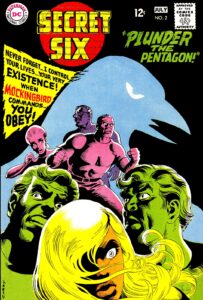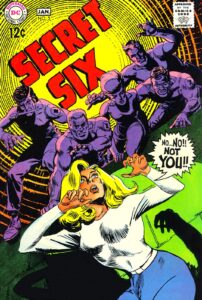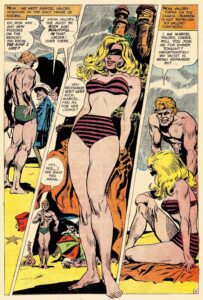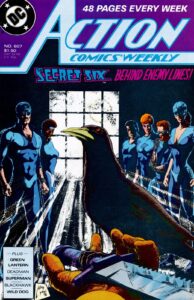Secrets of the Secret Six
by Will Morgan 23-Jan-22
Writer E. Nelson Bridwell had clearly been briefed to rip-off Mission: Impossible as closely as possible, but, just as he did with the Inferior Five, he took that basic remit, and tweaked it into something unique.
 [With grateful acknowledgment to Keith W. Williams, whose similarly-titled article in the 1970s informed much of my thinking on the topic.]
[With grateful acknowledgment to Keith W. Williams, whose similarly-titled article in the 1970s informed much of my thinking on the topic.]
The TV show, Mission: Impossible, debuted in 1966, each episode opening with the team’s field leader selecting a task force from multiple dossiers to combat the Menace of the Week. In theory, this could have resulted in a cast of dozens; in reality, contractual obligations ‘selected’ the same few series regulars, plus maybe one guest-star, but nevertheless the series was a huge hit, running to 1973 for more than 150 episodes.
What’s this got to do with comics? Well, in the late Sixties, DC was changing. Responding to the challenge posed by the rise of Marvel Comics, they were trying for new audiences, and a lot of experimental titles were being launched.
One such was Secret Six, a 1968 launch featuring a suspiciously-similar team of specialists recruited to perform covert missions, taking down targets beyond the reach of the law. Writer E. Nelson Bridwell had clearly been briefed to rip-off Mission: Impossible as closely as possible, but, similarly to his earlier work on the Inferior Five, he took that basic remit, and tweaked it into something quite distinctive.
In this case, the six protagonists were, as per M:I, specialists with distinctive skill sets, but each also possessed a secret weakness in their past which, if disclosed or exploited would cause imprisonment, disgrace, or death. The ‘Secret’ in the series’ title referred therefore not only to the covert nature of their missions, but to the shadowed pasts of our various heroes. And the biggest secret of all was that the group’s mysterious handler, code-named Mockingbird, was one of the team.
 King Savage was a stuntman and Korean War veteran, who broke under torture and betrayed his country. Mockingbird arranged his escape so that he became a decorated hero—but the truth would reveal him as a traitor. Carlo Di Rienzi was an escapologist and magician, whose wife was killed and his son crippled in a revenge attack by organized crime. With Mockingbird’s treatments, the boy will eventually walk again—as long as Carlo plays ball. Lili Du Neuve, actress and disguise expert, was falsely accused of murder and headed for the guillotine, until an equally mendacious alibi got her acquitted. But the alibi can be recanted in a heartbeat. Tiger Force, former heavyweight champion, on the run from the Mob after refusing to throw a fight, was given a new name and life by Mockingbird. Dr August Durant, noted physicist, was infected by enemy agents with a lethal virus for which only Mockingbird has the cure—doled out at meagre intervals, to ensure Doc’s compliance. And finally there was Crimson Dawn, model, whose unusual upbringing gave her prowess in martial arts and marksmanship, but whose naiveté led her into an abusive marriage. Mockingbird literally reshaped her into a glamorous icon—whose sordid past could be revealed at any time.
King Savage was a stuntman and Korean War veteran, who broke under torture and betrayed his country. Mockingbird arranged his escape so that he became a decorated hero—but the truth would reveal him as a traitor. Carlo Di Rienzi was an escapologist and magician, whose wife was killed and his son crippled in a revenge attack by organized crime. With Mockingbird’s treatments, the boy will eventually walk again—as long as Carlo plays ball. Lili Du Neuve, actress and disguise expert, was falsely accused of murder and headed for the guillotine, until an equally mendacious alibi got her acquitted. But the alibi can be recanted in a heartbeat. Tiger Force, former heavyweight champion, on the run from the Mob after refusing to throw a fight, was given a new name and life by Mockingbird. Dr August Durant, noted physicist, was infected by enemy agents with a lethal virus for which only Mockingbird has the cure—doled out at meagre intervals, to ensure Doc’s compliance. And finally there was Crimson Dawn, model, whose unusual upbringing gave her prowess in martial arts and marksmanship, but whose naiveté led her into an abusive marriage. Mockingbird literally reshaped her into a glamorous icon—whose sordid past could be revealed at any time.
Each issue, Mockingbird assigned the team to incriminate, incarcerate, or sometimes eliminate enemies of the free world, globe-trotting operations (unusually for the time, fully half our heroes were non-American) with meticulously-constructed plots, relying on no contrivances or ‘cheats’, and grounded firmly in the bounds of reality; no superhumans or supernatural elements in the Six’s world. This verisimilitude was aided by artists Frank Springer (#1 & 2) and Jack Sparling (#3-7), whose naturalistic style added conviction to the series. In the case of Sparling in particular—a notoriously inconsistent artist, whose on-page presentation varied widely from one assignment to another—his work on the Six was some of his best.
 I mentioned earlier that credibility was a keynote of the series, but there was one overriding narrative coincidence; after the first couple of establishing issues, fate conspired to link the Six’s cases with events in their own histories. Over the course of the series, Lili revealed the true perpetrator of the crime she had been accused of, Carlo avenged the murder of his wife, and Crimson took healthy retribution upon her former husband, among other events. Had the series continued a few more issues, Mockingbird’s hold on the various members might have become so diluted as to be meaningless—although doubtless ENB would have come up with more reasons why the Six continued to operate.
I mentioned earlier that credibility was a keynote of the series, but there was one overriding narrative coincidence; after the first couple of establishing issues, fate conspired to link the Six’s cases with events in their own histories. Over the course of the series, Lili revealed the true perpetrator of the crime she had been accused of, Carlo avenged the murder of his wife, and Crimson took healthy retribution upon her former husband, among other events. Had the series continued a few more issues, Mockingbird’s hold on the various members might have become so diluted as to be meaningless—although doubtless ENB would have come up with more reasons why the Six continued to operate.
As it happened, though, he was denied the opportunity. Secret Six was cancelled with #7, one year after launch, and the group seemed destined to become a footnote in comics history, with the identity of Mockingbird still unrevealed.
This remained the case until 1988, and DC’s ill-advised and short lived attempt to relaunch Action Comics as a weekly anthology title, with a variety of short serialized strips. Most of these were pretty dismal, but one stood out as a quality successor. In Action Comics Weekly #601, writer Martin Pasko brought us a new Secret Six series.
 Unlike most comics characters, who live in an eternal ageless ‘now’, the Six had aged in real time. Twenty years after their last recorded adventure, the youngest was now in her forties, and the elder teammates pensioners, some of them broken down by age and infirmity. After two decades of inactivity, they were summoned once more by Mockingbird to train their successors—but en route, their plane crashes, with fatal results.
Unlike most comics characters, who live in an eternal ageless ‘now’, the Six had aged in real time. Twenty years after their last recorded adventure, the youngest was now in her forties, and the elder teammates pensioners, some of them broken down by age and infirmity. After two decades of inactivity, they were summoned once more by Mockingbird to train their successors—but en route, their plane crashes, with fatal results.
The new Secret Six, therefore, have to go into the field untrained. Mitch Hoberman, special effects tech crippled by arthritis; Ladonna Jameal, actress disfigured and rendered mute by an acid attack; Tony Mantegna, journalist deafened in an explosion; Luke McKendrick, paraplegic former track star; Vic Sommers, ex-marine blinded by shrapnel; and Dr Maria Verdugo, computer scientist with incurable epilepsy.
All have the same incentive to comply. Having become disabled, their former skills and talents are restored by cybernetic devices, enabling them to resume their former lives—and to do Mockingbird’s bidding. Because one of the original Six survives. And Mockingbird can remotely disable his (or her) ‘gifts’ at any moment, if the Six fail to comply.
In two 12-chapter serials (Action Comics Weekly #601-612, and 619-630), Pasko did an exemplary job of both evoking and updating the original series, tying in missions to a larger story arc, and eventually resolving the question of who was Mockingbird, in a way that was entirely appropriate and satisfying to readers of the original. In this, he was aided by two veteran artists; the criminally underestimated Dan Spiegle illustrated the first serial, and in a pleasing nostalgic touch, the second was drawn by Frank Springer, the very first Secret Six artist. Each skilfully retained the authentic grounding of the series, with only one fantastic element—the cybernetic/bionic devices supplied by Mockingbird, borderline science-fiction in their sophistication—and that not significantly detracting from the strip’s matter of fact tone.
The strip concluded with the possibility of a new Mockingbird, and an opening for a further sequel; but having been largely lost in the morass of inferior material in ACW—often described as Action Comics Weakly because of its shoddy content—the strip caused no ‘ripples’. The name was subsequently shoplifted for Gail Simone’s unrelated super-villain team-up title, so the original Secret Six remains unacknowledged by the DC Universe at large.
 Well, except for the far-better-than-it-ought-to-be Scooby-Doo Team-Up; in issue #30 (of the print version; #59 & #60 of the online version, don’t ask), the original line-up of the Secret Six made an appearance, together with Cave Carson’s crew, Rip Hunter’s team, the Challengers of the Unknown and the Sea Devils! It’s not canonical—but it is charming as hell, and, again, the secret of Mockingbird is disclosed!
Well, except for the far-better-than-it-ought-to-be Scooby-Doo Team-Up; in issue #30 (of the print version; #59 & #60 of the online version, don’t ask), the original line-up of the Secret Six made an appearance, together with Cave Carson’s crew, Rip Hunter’s team, the Challengers of the Unknown and the Sea Devils! It’s not canonical—but it is charming as hell, and, again, the secret of Mockingbird is disclosed!
Fear not; there are no spoilers here. You want the identity of Mockingbird, you won’t get it from me. Google it. Or better yet, buy the comics—there aren’t that many to hunt down, and they well reward reading.
Tags: Action Comics, Action Comics Weekly, Mission: Impossible, Scooby-Doo Team-Up, Secret Six